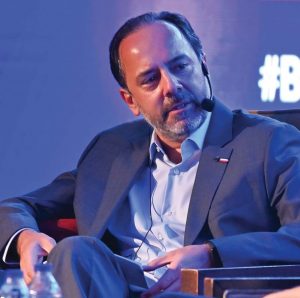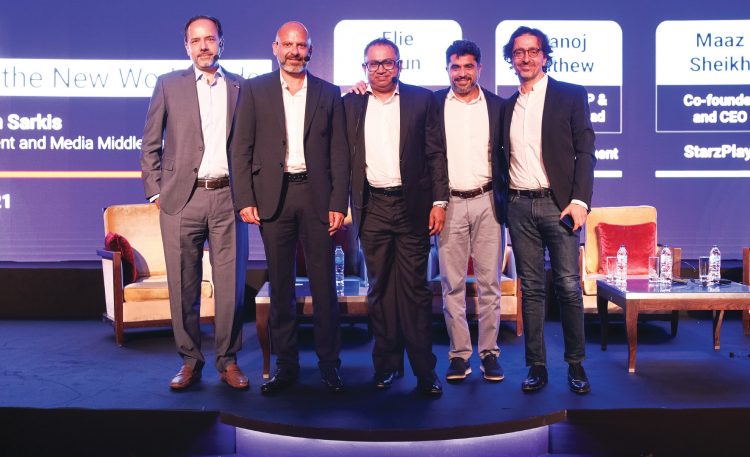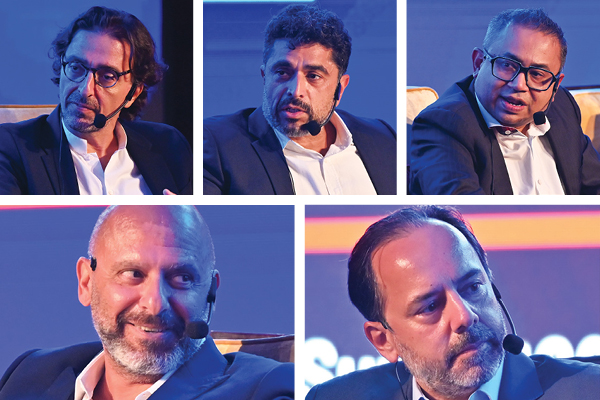The popular CEO panel was back at the ASBU BroadcastPro Summit, with industry stakeholders examining the status quo and discussing their plans for 2022 and strategies to maintain a commercially viable position in a continuously evolving new world order. Vijaya Cherian sums up the discussion.
With OTT platforms dominating the media landscape and gaining more traction during the pandemic, moderator Karim Sarkis, Partner Entertainment and Media – Middle East | Strategy&, kicked off the discussion by asking if the Arab world was closer to being taken over by streamers. Participating were Elie Aoun, CEO Media MEA, Ipsos; Manoj Mathew, Executive VP & Territory Head, Zee Entertainment (MENAPT); Maaz Sheikh, co-founder and CEO of StarzPlay; and Olivier Bramly, CEO of E-Vision.
While the panellists acknowledged the increasing uptake of streaming services and agreed that globally the scales are tipping in favour of OTT, they felt that the Middle East continues to have a faithful linear audience and that the status quo is unlikely to change at least for the next five to six years, with the relationship between linear and OTT more complementary than competitive.

“We see streaming platforms as complementing and completing the entertainment experience. In Saudi Arabia, AVOD/SVOD penetration is around 65% – and if you add to that social media uptake, it would be around 95% – but linear and free-to-air TV continue to enjoy a huge presence. In fact, during the pandemic, all-round watching in Saudi Arabia, whether on linear or streaming, went up by an additional hour,” Aoun commented.
As someone who operates in both the linear and on-demand space, Bramly seconded Aoun’s opinion. “Etisalat has enjoyed a steady consumption on linear”, with linear and free-to-air “the main go-to source for news, sport, live or shows in this region.”
Perhaps the most surprising comments came from Maaz Sheikh. “It’s hard for me to argue against linear when in the last two months, we’ve launched 20 linear channels on our OTT service,” he remarked, adding that StarzPlay had invested several millions of dollars in infrastructure and licensing to get linear channels onto his platform.
One of the reasons StarzPlay took the linear route initially was to run sports content. Seeing its success, the streamer began to add more linear content.
“We had the Asian qualifiers. It was one of the biggest consumption days we ever had on our platform. So, yes, linear does work and more recently we’ve added five of Star’s premium linear channels to our cricket pack. For us as a service, it has always been about experimentation and seeing what works. Football was extremely successful for us. So we tried cricket and it has been very successful with the subcontinent audience. So now we’re adding more Indian and Pakistani content. Given this scenario, I can’t argue against the linear channels.”
“With multiplexes, cinemas have a much smaller number of seats but the revenue has gone up, because those consumers who are going are willing to pay for that premium experience” – Manoj Mathew, Executive VP & Territory Head, Zee Entertainment (MENAPT)
Clarifying why StarzPlay has embraced linear on its streaming service, Sheikh explained that it all depends on the availability of rights. “I was speaking to an industry colleague here who has two or three great English-language linear channels where the rights are attractive but they won’t be available for SVOD. So if I want that specific content, I’ll go get the linear channel if the SVOD isn’t available. The choice to pick linear channels, therefore, could be the availability of the rights. It could be also that the production costs are spread across different platforms, but rights is the first driver.”

Manoj Mathew from Zee Entertainment explained how the availability of more devices has led to increased consumption within a family. Where in the past all five members of a family would have been watching one piece of content on a linear platform, today two would probably be watching on the linear platform while the other three may be watching on other devices.
He pointed to another phenomenon evident when fans watch a game like cricket in the stadium but also watch it in parallel on Switch TV or StarzPlay because they want a close-up of the action, and added that although each country in MENA requires a different marketing strategy, Arabic is the common denominator, making it easier for a streaming platform to target the whole region. Not everyone agreed about that, given that different dialects and versions prevail in different parts of the Arab world.
Sheikh commented, “It is extremely difficult in this part of the world to scale with one product that fits all. You have to go into each sub segment, because the region is very fragmented in terms of tastes. There are the different Arabic dialects to contend with. Content that works in the GCC doesn’t work in North Africa and vice versa. But also, within the Gulf countries you have such a large expatriate population that you can’t have a single product that appeals to everyone.

“So what we’ve been doing gradually is begin to target each one of these sub segments. For example, a year and a half ago we went into Turkish content and then got it dubbed into Arabic. Then earlier this year we went into anime and now have a thousand hours of anime content. Our most recent foray has been into sports. If you want to become a dominant service in the region, you cannot have a product that you think is going to fit across the board. You have to cater to each micro segment.”
Aoun agreed, pointing out that in terms of language the region has the Gulf, North Africa, Egypt and perhaps the Levant. He said that perhaps the most understood language en masse is Syrian, which is why most of the Turkish drama series are dubbed into Syrian. This was why the likes of MBC opened local channels in countries like Egypt and Iraq – so they could connect directly with the local populace.
Karim then moved the discussion to advertising, questioning the recent direction of this revenue source. Elie set the context by stating that the region used to be known for the advertising revenue in TV, until digital platforms claimed more revenue than TV from 2019 onwards, and continue to grow.
“The problem here is that for no reason, in my opinion, the advertising expenditures are dropping on linear TV while they’re growing on all the other digital platforms. We are hoping that expenditures on linear will start to stabilise or start growing by 1-3%, like any other place in the world. But there has been a huge drop in the last three or four years. In my opinion, that is not justified at all.”
“It’s hard for me to argue against linear when in the last two months, we’ve launched 20 linear channels on our OTT service” – Maaz Sheikh, co-founder and CEO, StarzPlay
As someone who recently used linear platforms to promote StarzPlay, Sheikh admitted: “Visibility is pretty much the same on linear as well. Digital seems more high-tech, but when we started advertising on Evision’s linear channels like Emasala and the Fox channels in year four and five, we realised that the audience reach was pretty similar.”
He elaborated: “One of the things we did was establish a baseline of our app downloads or our traffic, and then we would correlate it with when we had the spots on the linear channels, to see what happens to our direct and organic traffic. It showed linear channels to be a very effective advertising platform for us. So for us, the visibility was pretty much the same between digital and linear. I think it may be a lack of awareness or education among merchants and clients like ourselves. We need to develop our own measuring technicality to establish that causality. If you can measure the impact on your service or your growth or your revenue, then it’s worth investing into it, which is what we did.”
 The discussion then moved to the close relationship between telcos and streamers, with increasing signs of collaboration between regional players. Karim questioned if Etisalat really required a Switch TV service and STC Jawwy TV, when they were also simultaneously partnering with the likes of StarzPlay and perhaps cannibalising their streaming services.
The discussion then moved to the close relationship between telcos and streamers, with increasing signs of collaboration between regional players. Karim questioned if Etisalat really required a Switch TV service and STC Jawwy TV, when they were also simultaneously partnering with the likes of StarzPlay and perhaps cannibalising their streaming services.
Bramly explained that there is no contradiction, as what the telco can do in terms of reach with its app is not something StarzPlay could potentially achieve; and Sheikh cited two instances of why the telcos are justified in having their own streaming services and how they could potentially provide more content at a scale which smaller services such as StarzPlay could not afford.
For instance, for the Cricket World Cup Etisalat created a special prepaid mobile pack that included Switch TV, offering the tournament to approximately 3m customers. Likewise, Jawwy offers a lot of free Arabic content which StarzPlay can ill afford to provide.

When Sarkis maintained that they were once again setting the stage for global players like Disney to come and take over the regional market as they did with linear, Bramly explained that they would need to collaborate with local players: “They need telcos and paid TV platforms to provide a significant volume of subscribers quickly on a weekly basis.”
Sheikh added that they would also be careful to protect their existing assets, because if the likes of OSN walked away from the content licensing business, the studios would lose hundreds of millions of dollars. “So I think they look for these partnerships to protect their downside also.”
Matthew pointed out that syndication may be a good way to ensure they are prepared to take on global players – Netflix would start syndicating its content to markets where it is not available or less watched, or the broadband penetration is not there. He said Zee was doing the same.
Sheikh said that if Disney comes to the region directly, there are five or six other major studios that the regional players can work with, who don’t have plans to launch their service in this region.
“We see a very solid pipeline for the next four to five years. And then on top of that, the local industry has come of age so you no longer have to just look at, say, Egypt for content production. The Gulf has picked up and Syria and Lebanon are making a comeback. The availability of local content has increased.”

Perhaps one solid example of collaboration is how the local partners are bonding to secure sports rights. Bramly called it a win-win when Evision experimented with sports rights by collaborating with both StarzPlay and du: “By combining our complementary services, we managed to make a deal for this property and the result was positive for all parties.”
Sheikh argued that strategic collaboration has worked for everyone.
“StarzPlay is already competing with the likes of beIN. Previously, cricket was with OSN and then beIN, but now it’s on our service. The Asian Football Federation used to be on beIN. Abu Dhabi acquired the rights, but they are a free-to-air broadcaster and AFC needed to be encrypted. That’s where we came in. The channels were produced by Abu Dhabi TV, but available only through StarzPlay. And then we sub-licensed that to Etisalat and du. So the coexistence and collaboration is working, and we will see more and more of that.”
In closing, Karim asked for thoughts on how movies are adding to the business. Elie said that people go to cinemas for the experience, and Mathew commented that although the number of people going to cinemas may have fallen with the rise of multiplexes, those who do go are willing to pay more, so ARPU has gone up. “With multiplexes, cinemas have a much smaller number of seats but the revenue has gone up, because those consumers who are going are willing to pay for that premium experience.”

Sheikh remarked that StarzPlay sees a huge opportunity in bringing to its platform movies that skip the theatrical window. He cited Infinite from Paramount as a case in point.
“It did phenomenally well for us and although it was one of the most expensive movies we’ve ever purchased on our service, we got more than 100,000 unique users within the first two weeks we had it on the service, which is a very strong number for us and an indication of what our consumers are looking for.” The key takeaways from the discussion were that regional players are no longer just talking about collaboration, as in previous years, but successfully putting it into practice. Advertising revenue, though on the decline, seems to be giving way to new transactional models and the region seems to be adapting well to this. The theatrical business is gradually getting back on its feet, and seems to be going through a transition of its own.















































































